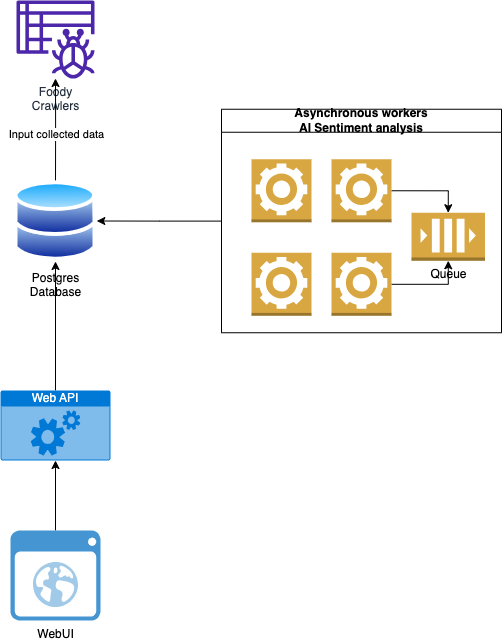- Python3.10 (Guideline how to upgrade https://cloudbytes.dev/snippets/upgrade-python-to-latest-version-on-ubuntu-linux)
- Docker or Docker Desktop for Win or MacOs
- Docker Compose
Create the .env file
LOG_LEVEL = "INFO"
DB_HOST = "db"
SCRAPY_SPLASH_HOST = "scrapy_splash"
POSTGRES_USER = "postgres"
POSTGRES_PASSWORD = "postgres"
POSTGRES_DB = "sentiment_analysis"
SCHEDULE = "120"
REDIS_URL = "redis://:eYVX7EwVmmxKPCDmwMtyKVge8oLd2t81@cache:6379/0"The following commands will clone the sub-modules of sentiment research
brew install git-lfs # MACOS
# sudo apt install git-lfs # Ubuntu
cd model-research/phobert-base-vietnamese-sentiment
git clone git@hf.co:wonrax/phobert-base-vietnamese-sentimentThe following commands wll use docker-compose to spin up all the follow services:
- scrapy_splash: an extension for Scrapy to use headless browser for login
- crawler: just build image (Due to CPU extensive, we don't recommend to use it in docker)
- cache: Redis
- db: Postgres
- sentiment: AI workere which host model from https://huggingface.co/wonrax/phobert-base-vietnamese-sentiment
- schedule_extraction_beat: worker scheduler
- webapi: the Rest API powered by FastAPI
If it does not work for the 1st time, try to make down and run the following commands again
make allUpdate the .env with the following value to make crawler can connect to Database and scrapy splash
DB_HOST = "localhost"
SCRAPY_SPLASH_HOST = "localhost"The following commands will run the spider
cd app/crawler
# Run the bellow in case your default python < 3.10
sudo apt install python3.10-venv
python3.10 -m venv .venv
source .venv/bin/activate
pip install -r requirements.txt
scrapy crawl foodyBrowse: http://localhost:3000/
Username: CTV
Password: 1
Run unit test (Still in development)
cd app
chmod +x test_sentiment.sh
./test_sentiment.sh- black
- flake8
- isort
source .venv/bin/activate
pre-commit run --all-files- Not enough unit test
- CI/CD for smooth integration
- Docker size for worker may be optimized smaller
- Cache model with base class Celery for faster processing
- Production ochestration by k8s
- A Grafana stack for monitoring
